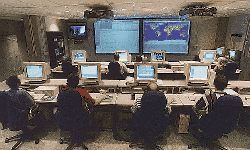
|
FUSE
|
Mission Status Report
|

Mission Status Report #22 Star Date: October 22, 1999
NOTE: Mission Status Reports on the web page will continue roughly once a week, as
events unfold.
-- Bill Blair


A graphic view of the FUSE on orbit (left) and
the Satellite Control Center at JHU (right).
(Click either image to see larger version.)
UPRM Ground Station Back to Operational
Time flies when you're having fun. I can't believe it has been 11 days since my last report!
We are all extremely relieved to have our ground station antenna at the University of Puerto
Rico back in service and working dependably again. It came back into service just a couple of days
after my last report and has been working well since then. It appears to have been a combination
of s/w and h/w problems that caused our difficulties, and a complete understanding of what
happened has been hard to reconstruct. However, it is working again now, and that's the most
important thing for operations! (And by the way, thank goodness hurricane Jose has decided
to turn to the north...)
It has been a good week for FUSE operations. Several important tests have run successfully and
we have seen a steady stream of science observations intermingled and executed as planned. The
test data are still being analyzed, but are beginning to confirm some of our suspicions about
the mirror focus and alignment difficulties we have been having. You may recall FUSE operates
with four separate telescope mirrors, each of which must be focussed and aligned with respect
to the others. We have clear evidence now that at least some of the time when we make a "focus"
motion (that is, just a movement up or down to change the mirror focus position), a "tilt" of one
or more of the mirrors is also introduced. Hence, if the mirrors were close to aligned before the
focus movement, they can become unaligned afterwards. We have also seen some evidence that the
mirrors can change their relative positions when we move between objects on the sky. Further
measurements to characterize the systematics of these mirror motions are now our highest priority
for the ongoing checkout activities. Between tests, we obtain science data with whatever mirrors
are aligned at that time, and we are getting some good data!
The FUSE Science team was in town last Thursday and Friday for a team meeting. In general, they left
with the impression that we have had some problems but that we are attacking those problems in a proper
and systematic way. They also got a look at some of our early science observations and were
very excited about the data even though we are not yet focussed and aligned. Since then, we have
had even more science results coming in and working their way out to the investigators. We
expect to have a very nice set of initial results to present at the American Astronomical
Society meeting in Atlanta in January 2000!
Reported by: Bill Blair, Chief of Mission Planning

|